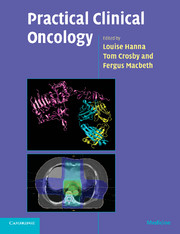Book contents
- Frontmatter
- Contents
- List of contributors
- Preface
- Acknowledgements
- Abbreviations
- 1 Practical issues in cytotoxic chemotherapy usage
- 2 Biological treatments in cancer
- 3 Hormones in cancer
- 4 Radiotherapy planning
- 5 Research in cancer
- 6 Oncological emergencies
- 7 Palliative care
- 8 Head and neck
- 9 Oesophagus
- 10 Stomach
- 11 Liver, gallbladder and biliary tract
- 12 Exocrine pancreas
- 13 Colon and rectum
- 14 Anus
- 15 Gastrointestinal stromal tumours
- 16 Breast
- 17 Kidney
- 18 Bladder
- 19 Prostate
- 20 Testis
- 21 Penis
- 22 Ovary
- 23 Body of the uterus
- 24 Cervix
- 25 Vagina
- 26 Vulva
- 27 Gestational trophoblast tumours
- 28 Lung
- 29 Mesothelioma
- 30 Soft tissue and bone tumours in adults
- 31 The lymphomas and myeloma
- 32 Central nervous system
- 33 Skin cancer other than melanoma
- 34 Melanoma
- 35 Thyroid
- 36 Neuroendocrine tumours
- 37 Cancer in children
- 38 Cancer of unknown primary
- 39 The use of radiotherapy in the treatment of benign conditions
- Multiple choice questions
- Multiple choice answers
- Index
- References
10 - Stomach
Published online by Cambridge University Press: 23 December 2009
- Frontmatter
- Contents
- List of contributors
- Preface
- Acknowledgements
- Abbreviations
- 1 Practical issues in cytotoxic chemotherapy usage
- 2 Biological treatments in cancer
- 3 Hormones in cancer
- 4 Radiotherapy planning
- 5 Research in cancer
- 6 Oncological emergencies
- 7 Palliative care
- 8 Head and neck
- 9 Oesophagus
- 10 Stomach
- 11 Liver, gallbladder and biliary tract
- 12 Exocrine pancreas
- 13 Colon and rectum
- 14 Anus
- 15 Gastrointestinal stromal tumours
- 16 Breast
- 17 Kidney
- 18 Bladder
- 19 Prostate
- 20 Testis
- 21 Penis
- 22 Ovary
- 23 Body of the uterus
- 24 Cervix
- 25 Vagina
- 26 Vulva
- 27 Gestational trophoblast tumours
- 28 Lung
- 29 Mesothelioma
- 30 Soft tissue and bone tumours in adults
- 31 The lymphomas and myeloma
- 32 Central nervous system
- 33 Skin cancer other than melanoma
- 34 Melanoma
- 35 Thyroid
- 36 Neuroendocrine tumours
- 37 Cancer in children
- 38 Cancer of unknown primary
- 39 The use of radiotherapy in the treatment of benign conditions
- Multiple choice questions
- Multiple choice answers
- Index
- References
Summary
Introduction
There has been a steady decline in the incidence of gastric cancer in most countries in the world in the past 50 years. However, gastric cancer remains a major health problem: it is the sixth most common malignancy in the UK and the second most common cause of cancer-related death worldwide. Despite the decline in the cancer that was previously most common, the distal type of cancer, there has been a rapid rise in cancers affecting the gastro-oesophageal junction and cardia, particularly among young white people, which reflects changes in aetiological factors.
The only current curative treatment is surgery, but in the UK most patients present late with locally advanced or metastatic disease. Only 25 to 40% of cases are amenable to potentially curative surgery, and, even in these cases, local recurrence may occur in up to 50% and the 5-year survival is 30 to 40%. Because of this and because response rates to combination chemotherapy are 40 to 50% in patients with advanced disease, adjuvant therapy is being used increasingly. Perioperative chemotherapy is used most commonly in the UK, whereas postoperative chemoradiotherapy is standard treatment in the USA.
Types of tumour
The types of tumour that affect the stomach are shown in Table 10.1. Adenocarcinoma accounts for 95% of all malignant tumours.
Anatomy
The stomach begins at the gastro-oesophageal junction and ends at the pylorus. It is anatomically defined in three parts: the proximal fundus (cardia), the body, and the distal pylorus (antrum).
- Type
- Chapter
- Information
- Practical Clinical Oncology , pp. 132 - 140Publisher: Cambridge University PressPrint publication year: 2008



